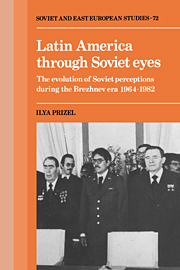 Latin America through Soviet Eyes
Latin America through Soviet Eyes Published online by Cambridge University Press: 05 February 2012
The idea of Latin American unity is as old as the region's independence. Latin America's founding fathers, especially Bolívar, envisaged either one huge Spanish-speaking state, stretching from Mexico to Argentina, or an alternative of no more than three states. Although Bolívar's dream failed to materialize, and the four viceroyalties of Spanish America fragmented into eighteen separate states, the idea of unity has nevertheless continued to evoke a response throughout Latin America.
During the nineteenth century, the Latin American states periodically revived the idea of regional unity when they perceived a threat of foreign aggression. Four congresses were called in response to, for example, fears that Spain might attempt to reintroduce colonialism in the hemisphere. The absence of concrete results at these conferences, and of exterior threats to the territorial integrity of the Latin American states after 1865, resulted in declining interest in political unity.
Unlike the idea of political unity, the notion of economic unity did not emerge until after World War II. The lack of economic intercourse within Latin America can be attributed in part to the continent's vast physical scale and the impassable terrain separating different areas. Furthermore, the region's infrastructure obstructed the development of inter-Latin American trade, since any economic development that had occurred was designed to serve a specific foreign market – usually European or North American.
A basis was laid for expanding trade among the region's republics when several larger states undertook an “export substitution” policy during the Great Depression.
To save this book to your Kindle, first ensure [email protected] is added to your Approved Personal Document E-mail List under your Personal Document Settings on the Manage Your Content and Devices page of your Amazon account. Then enter the ‘name’ part of your Kindle email address below. Find out more about saving to your Kindle.
Note you can select to save to either the @free.kindle.com or @kindle.com variations. ‘@free.kindle.com’ emails are free but can only be saved to your device when it is connected to wi-fi. ‘@kindle.com’ emails can be delivered even when you are not connected to wi-fi, but note that service fees apply.
Find out more about the Kindle Personal Document Service.
To save content items to your account, please confirm that you agree to abide by our usage policies. If this is the first time you use this feature, you will be asked to authorise Cambridge Core to connect with your account. Find out more about saving content to Dropbox.
To save content items to your account, please confirm that you agree to abide by our usage policies. If this is the first time you use this feature, you will be asked to authorise Cambridge Core to connect with your account. Find out more about saving content to Google Drive.